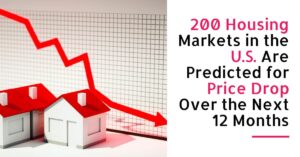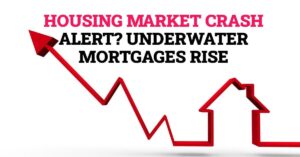Zillow's latest report predicts a potential cooling-off period for the U.S. housing market. Out of 894 markets, roughly 22% (around 200) are expected to see home price declines over the next year (by March 2025). Prices are projected to hold steady in about 1% of markets, while the remaining 77% (roughly 684) can anticipate some level of price growth.
The United States is expected to see a 1.4% increase in home prices by March 31, 2025. This information is consistent with other housing market forecasts for the country, which predict a slowdown or modest growth in home prices over the next year. This projection signals a potential shift in the U.S. real estate market, prompting both homeowners and investors to closely monitor these developments.
Market Forecast Analysis by States
Here's a breakdown of housing market predictions across several states:
- Louisiana: A mixed bag. Expect slight declines in Bogalusa, Morgan City, and Houma. Alexandria, New Orleans, and Hammond may see more moderate decreases.
- Texas: Varied trends. Beeville, Sweetwater, and Zapata could dip, while Raymondville, Beaumont, and Midland might see marginal decreases.
- Mississippi: Range of outcomes. Greenville and Greenwood might see slight declines, while Vicksburg and Columbus have a more favorable outlook with minimal dips.
- Pennsylvania: Moderate declines are expected in DuBois and Sunbury, with slight decreases for Selinsgrove and Altoona.
- Arkansas: Modest declines are anticipated in Forrest City and Magnolia, while Camden might see a slight decrease.
- California: Ukiah and Eureka could experience modest declines, while Santa Rosa and Sonora might see marginal dips.
- Alaska: Fairbanks and Anchorage might see modest declines, with Juneau experiencing a marginal decrease.
- Illinois: Quincy and Macomb anticipate modest declines, while Champaign and Springfield could see marginal decreases.
- Oklahoma: Slight declines are expected in Woodward and Enid, with a marginal decrease for Elk City.
- Ohio: Wheeling and Marietta could see modest declines, while Dayton and Athens might experience marginal decreases.
- Georgia: A mixed outlook. Albany and Waycross anticipate slight declines, while Atlanta could see a more moderate decrease.
- Michigan: Varied trends. Lansing and Detroit anticipate modest declines, while Ann Arbor and Grand Rapids show marginal decreases.
- Colorado: Slight declines are expected in Denver and Colorado Springs, with Boulder and Fort Collins experiencing minimal changes.
- North Carolina: Charlotte and Raleigh anticipate modest declines, while Asheville and Wilmington show marginal decreases.
- Virginia: Similar trends with Norfolk and Richmond anticipating slight declines, while Arlington and Alexandria show minimal decreases.
- Wisconsin: Milwaukee and Madison anticipate modest declines, while Green Bay and Appleton show marginal decreases.
- Arizona: Phoenix and Tucson anticipate slight declines, with Scottsdale and Mesa showing minimal decreases.
- New Jersey: Newark and Jersey City anticipate modest declines, while Princeton and Edison show marginal decreases.
- Florida: Miami and Orlando anticipate slight declines, while Tampa and Jacksonville show minimal decreases.
- New York: New York City and Buffalo anticipate modest declines, while Albany and Syracuse show marginal decreases.
Top 10 Housing Markets Which Will See the Highest Drop in Home Prices
The report also provides detailed insights into various metropolitan statistical areas (MSAs) and their expected performance in terms of housing prices. Here are some notable findings about those markets that top the list for the anticipated decrease in home prices:
- McComb, MS: The MSA in Mississippi is forecasted to experience a 1% decrease in housing prices by March 2025, with a -2.6% decline by June 2024 and a further decline of -8.3% by March 2025.
- Hobbs, NM: Housing prices in this New Mexico MSA are expected to remain relatively stable, with a slight increase of 0.2% by April 2024. However, a decline of -0.7% is anticipated by June 2024, followed by a more significant decline of -8.1% by March 2025.
- DeRidder, LA: The Louisiana market is predicted to see a modest change with no increase by April 2024, followed by a -1.2% decrease by June 2024 and a further decline of -8% by March 2025.
- Cleveland, MS: Another Mississippi MSA, Cleveland, is forecasted to have a 0.6% increase in prices by April 2024, despite a -0.4% decline by June 2024. The decline is expected to deepen to -8% by March 2025.
- Lamesa, TX: Housing prices in this Texas MSA may face challenges, with a projected decline of -0.7% by April 2024, followed by a more substantial decline of -2.5% by June 2024 and a further decrease of -8% by March 2025.
- Opelousas, LA: This Louisiana MSA is expected to see a decline of -0.3% by April 2024, followed by a -1.2% decrease by June 2024 and a further decline of -7.9% by March 2025.
- Helena, AR: Housing prices in this Arkansas MSA are forecasted to experience a 0.6% increase by April 2024, with stability maintained by June 2024. However, a decline of -7.9% is anticipated by March 2025.
- Alice, TX: The Texas MSA of Alice is predicted to face a -0.2% decrease by April 2024, followed by a further decline of -0.9% by June 2024 and a decrease of -7.8% by March 2025.
- Johnstown, PA: This Pennsylvania MSA is forecasted to experience a significant decline of -1.7% by April 2024, followed by a further decrease of -3.4% by June 2024 and a decline of -7.7% by March 2025.
- Clarksdale, MS: Housing prices in Clarksdale, Mississippi, are anticipated to decline by 0.7% by April 2024, with a further decrease of -3.1% by June 2024 and a decline of -7.7% by March 2025.
- Pecos, TX: The Texas MSA of Pecos is predicted to see no change by April 2024, followed by a -1.2% decrease by June 2024 and a further decline of -7.5% by March 2025.
- Kennett, MO: Housing prices in Kennett, Missouri, may face challenges with a projected decline of -0.3% by April 2024, followed by a -1.2% decrease by June 2024 and a decline of -6.9% by March 2025.
- Lake Charles, LA: This Louisiana MSA is forecasted to see an increase of 0.4% by April 2024, followed by a slight decline of -0.1% by June 2024. However, a decline of -6.6% is anticipated by March 2025.
- Big Spring, TX: Housing prices in Big Spring, Texas, are anticipated to see no change by April 2024, followed by a decline of -1.8% by June 2024 and a further decrease of -6.5% by March 2025.
Potential Factors Driving Price Declines in these Markets
Several factors may contribute to the predicted price declines in the identified housing markets, including:</ p>
- Economic Conditions: Local economic factors such as job growth, income levels, and industry performance can influence housing demand and affordability.
- Supply and Demand Dynamics: Imbalances between housing supply and demand, including excess inventory or limited buyer interest, may put downward pressure on prices.
- Market Sentiment: Perception of market conditions, interest rates, and broader economic trends can influence consumer confidence and housing market activity.
Zillow's forecast of price drops in 200 housing markets highlights the ever-changing real estate sector. These predictions are helpful for anyone involved, but it's important to remember that local markets are influenced by many factors. No matter if you're an owner, buyer, or investor, staying up-to-date and flexible is key to navigating a shifting market.











